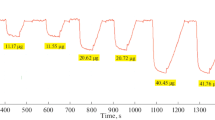Abstract
Thiourea was estimated in amounts ranging from 40 μg up to 1.5 mg/20 ml by oxidimetric titration with anodically generated bromine as intermediate reagent. In the work presented, an experimental set-up for coulometric titrations with automatic, potentiometric end-point detection has been described, which is suited for the accurate determination of substances up to 10−6 equivalents. A borax-KH2PO4-buffer solution of pH 5.8, with 2% KBr addition, served as supporting electrolyte. The Au-SCE indicator electrode system was successfully employed for the location of the endpoint.
Under the given experimental conditions, urea and sulphuric acid are formed as the products of oxidation of thiourea followed by hydrolysis. This reaction corresponds to an 8-electron transfer per mole of thiourea. This will be a rapid, direct and accurate method for the determination of thiourea. Amounts ranging from 0.11–0.75 mg can be determined with an average error of 0.1–0.5%, and beyond 1 mg with about 0.06%.
Zusammenfassung
Thioharnstoff wurde in Mengen von 40 μg bis 1,5 mg pro 20 ml durch oxydimetrische Titration mit anodisch erzeugtem Brom als Zwischenreagens bestimmt. Für diesen Zweck wurde eine Apparatur für coulometrische Titrationen mit automatischer potentiometrischer Endpunktindikation beschrieben, welche für die genaue Bestimmung von Stoffen bis zu 10−6 Äquivalenten geeignet ist. Eine Borax-KH2PO4-Pufferlösung von pH 5,8, mit einem Zusatz von 2% KBr, diente als Leitelektrolyt. Das Au-GKE-Indicatorsystem wurde für die Endpunktsermittlung sehr erfolgreich verwendet.
Unter den angegebenen Versuchsbedingungen bilden sich durch Oxydation und Hydrolyse Harnstoff und Schwefelsäure. Diese Reaktion entspricht einem 8-Elektronenübergang pro Mol Thioharnstoff. Darauf läßt sich eine schnelle und sehr genaue Methode zur Bestimmung von Thioharnstoff gründen. Mengen von 0,11 bis 0,75 mg können mit einem mittleren Fehler von 0,1–0,5% bestimmt werden, Mengen über 1 mg mit einem Fehler von ca. 0,06%.
Similar content being viewed by others
Literatur
McGowan, G.: J. Chem. Soc., Transactions (London) 49, 195 (1886); 51, 378, 379 (1888). — J. Prakt. Chem. (2), N. F. 36, 216 (1887)
Meyer, F. R., Ronge, G.: Z. Angew. Chem. 52, 637 (1939)
Sivaramaiah, G.: Beiträge zur Verwendung von elektrolytisch erzeugten Oxydationsmitteln als Urtitersubstanzen für Redoxtitrationen, Kap.2. Diss. TU Dresden, Sekt. Chemie 1970
Sivaramaiah, G., Dörfel, Ch.: Chem. Technik, eingereicht
Tabellenbuch Chemie, Autorenkollektiv, S. 318. Leipzig: VEB Deutscher Verlag für Grundstoffindustrie 1966
Author information
Authors and Affiliations
Additional information
Durchgeführt im Rahmen der Dissertation des Autors während seiner Aspirantenzeit von September 1967 bis Dezember 1970 an der Technischen Universität Dresden im Bereich Physikalische und Elektrochemie der Sektion Chemie.
Rights and permissions
About this article
Cite this article
Sivaramaiah, G. Coulometrische Bestimmung des Thioharnstoffs durch oxydimetrische Titration mit Brom. Z. Anal. Chem. 270, 274–278 (1974). https://doi.org/10.1007/BF00431325
Received:
Issue Date:
DOI: https://doi.org/10.1007/BF00431325




